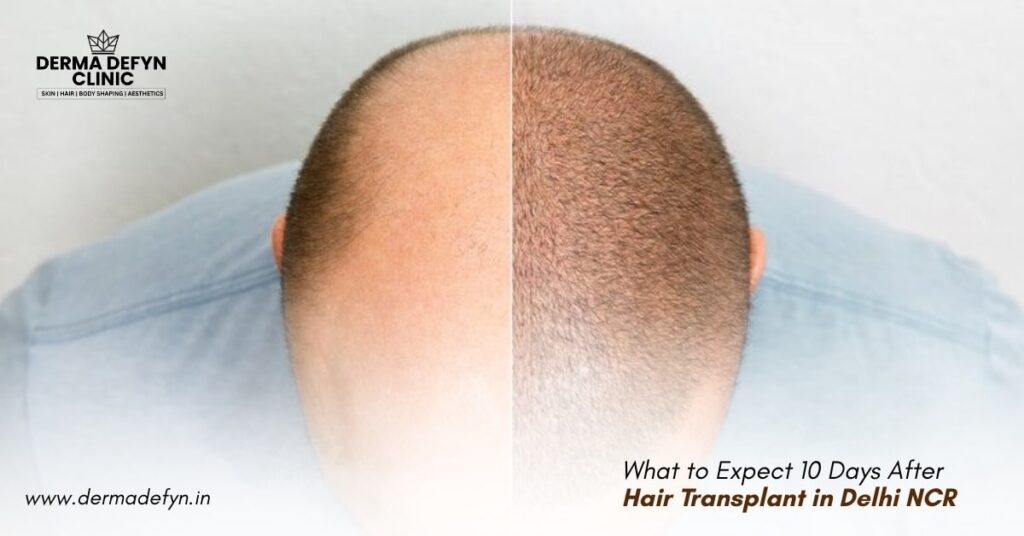The 10-day mark after a hair transplant in Delhi represents a crucial milestone in your recovery journey. At this stage, you’re likely wondering: Is my scalp healing properly? Can I finally return to my normal routine? What should I realistically expect to see?
The truth is, 10 days hair transplant in Delhi/NCR is when many patients experience both relief and anxiety. The initial discomfort has subsided, but visible results remain months away.
Understanding what’s normal at this critical juncture can help set proper expectations and ensure you’re taking the right steps for optimal healing.
This comprehensive guide will walk you through everything happening during your second week of recovery, from scab formation to activity restrictions, giving you the knowledge to navigate this phase with confidence.
Initial Days After Hair Transplant in Delhi: Setting the Stage
Before diving into day 10 specifics, it’s important to understand what leads up to this milestone. The first 3 days post-surgery are the most critical for graft survival.
During this period, your transplanted follicles are establishing a blood supply and beginning the healing process.
Days 1-3 typically involve significant scalp sensitivity, mild swelling, and the formation of small scabs around each transplanted follicle. These scabs serve as protective barriers, safeguarding your new hair grafts during their most vulnerable phase.
By day 4-7, most patients notice a reduction in swelling and tenderness. The scalp begins returning to its normal color, though some redness may persist, particularly in patients with lighter skin tones.
What to Expect 10 Days Post-Op: The Healing Milestone
Scab Formation and Natural Removal
At 10 days post-transplant, scab formation and removal become the primary focus. Most patients find their scabs are ready to be gently removed through proper washing techniques. These crusts, which have protected your grafts during their most fragile period, should now detach easily with minimal manipulation.
The scab removal process varies significantly between patients. Some may find most scabs wash away during their first thorough cleaning on day 10, while others may need several gentle washing sessions over the next few days. This variation is completely normal and depends on factors like skin type, healing speed, and aftercare compliance.
Important signs your scabs are ready for removal:
- They appear loose and easily movable
- No bleeding occurs when gently touched
- The underlying skin appears pink and healthy
- Scabs detach with minimal water pressure
Scalp Appearance and Healing Progress
By day 10, most patients notice significant improvements in their scalp’s appearance. The angry red coloration that characterized the first week has typically faded to a mild pink hue. Swelling should be completely resolved, and the transplant area should look relatively normal to casual observers.
However, it’s crucial to understand that healing varies based on several factors. Patients with sensitive skin may experience prolonged redness lasting 2-3 weeks. Those who’ve undergone extensive procedures covering large areas might heal more gradually than patients with smaller transplants.
The donor area, where follicles were extracted, typically heals faster than the recipient site. Most patients find that their donor region appears nearly normal by day 10, with only minor redness remaining.
Graft Security: Are Your New Follicles Safe?
One of the most common concerns at 10 days post-transplant involves graft security. The encouraging news is that by this point, your transplanted follicles should be well-established and significantly less fragile than during the first week.
Hair transplant side effects during this period are generally minimal. However, grafts aren’t completely secure until approximately 10-14 days post procedure. This means while you can resume many normal activities, you should still exercise caution around the transplant area.
Activities that are generally safe at 1O days:
- Gentle touching of the scalp
- Light physical activity and walking
- Return to work (for most occupations)
- Wearing loose-fitting hats
- Vigorous scalp massage
- High-impact exercise
- Tight headwear
- Direct sun exposure without protection
Returning to Work and Daily Activities
The question of when to return to work depends largely on your occupation and whether you can work remotely. For office workers who can work from home, returning to work as early as day 5 is often possible. However, if your job requires in-person interaction, waiting until day 10-14 ensures minimal visible signs of surgery.
Professional Considerations
For professionals in client-facing roles, the 10-day mark represents an important decision point. While your scalp has healed significantly, some residual redness or minor scabbing may still be visible. Consider these factors:
Favorable conditions for returning to work:
- Ability to style hair to cover the transplant area
- Indoor work environment
- Understanding colleagues or flexible dress codes
- No requirement for protective headgear. Reasons to wait longer:
- Highly visible public-facing role
- Outdoor work requiring sun exposure
- Jobs requiring tight-fitting helmets or hats
- Personal comfort level with appearance
Hair Transplant Before and After: Managing Expectations
At 10 days post-procedure, don’t expect to see dramatic hair transplant before and after differences. The transplanted hairs are still in their initial phase, and significant growth won’t be visible for several months.
What you might notice:
- Reduced redness and swelling
- A clearer definition of your new hairline
- Easier styling and grooming
- Return to normal scalp sensation
Hair Shedding and New Growth: The Natural Process
Perhaps the most anxiety-inducing aspect of the 10-day mark is the beginning of transplant hair shedding. Many patients are alarmed to see newly transplanted hairs falling out, but this is completely normal and expected.
Understanding Shock Loss
The shedding that begins around days 10-14 is called “shock loss” or telogen effluvium. This occurs because the trauma of transplantation causes hair follicles to enter a resting phase. The important thing to understand is that while the hair shaft falls out, the follicle root remains intact and will produce new hair in the coming months.
Shock loss can affect:
- Newly transplanted hairs (very common)
- Existing hairs around the transplant area (less common)
- Donor area hairs (rare but possible)
This shedding phase typically lasts 2-6 weeks, with new growth beginning around month 3-4 post-transplant.
Aftercare Importance: Your Path to Success
Proper aftercare at the 10-day mark is crucial for long-term success. While your grafts are more secure, they’re still healing and require attention.
Essential Aftercare Steps
Gentle cleansing routine: Use lukewarm water and mild, fragrance-free shampoo. Apply gentle pressure with your fingertips, never your nails. Pat dry with a soft towel rather than rubbing.
Sun protection: UV exposure can damage healing tissue and cause hyperpigmentation. Wear a loose hat or use zinc-based sunscreen when outdoors.
Moisturizing: Keep your scalp hydrated with recommended post-transplant products. Avoid heavy oils or fragrances that could irritate healing tissue.
Sleep position: While you can return to normal sleeping positions after 10 days, using a silk or satin pillowcase can reduce friction and hair breakage.
Best Hair Transplant cost in Gurgaon/Delhi
For those researching hair transplant costs, understanding the recovery process is crucial for planning time off work and associated expenses. Best hair transplant in Delhi cost & best hair transplant cost in Gurgaon vary significantly, but all quality procedures require similar recovery protocols.
The 10-day mark is when many patients feel confident enough to research future procedures or recommend their surgeons to others seeking the best hair transplant near me.
When to Seek Medical Advice
While most patients experience smooth healing by day 10, certain symptoms warrant immediate medical attention:
Red flags requiring urgent care:
- Severe pain or increasing discomfort
- Signs of infection (pus, fever, red streaking)
- Excessive bleeding or oozing
- Unusual swelling or skin changes
- Grafts that appear to be dislodging
- Mild itching (common as healing progresses)
- Occasional small scabs are still present
- Minor hair shedding beginning
- Slight scalp sensitivity
FAQ: Common 10-Day Recovery Questions
-
Can I exercise at 1O days post-transplant?
Light cardio and walking are generally acceptable, but avoid activities that cause excessive sweating or require protective headgear. Swimming should be avoided for at least one month.
-
Is it normal to see no hair growth at 1O days?
Absolutely. Visible hair growth typically doesn’t begin until 3-4 months post-transplant. The 10-day mark is about healing, not growth.
-
Can I use hair styling products?
Gentle, fragrance-free products are usually acceptable after day 10, but avoid anything containing alcohol or harsh chemicals.
-
How long will the redness last?
Most patients see significant improvement by day 10, with complete resolution by 2-3 weeks. Patients with sensitive skin may experience longer-lasting redness.
Your Recovery Journey Continues
The 10-day mark after your hair transplant in Delhi represents a significant milestone in your recovery journey. While you’re past the most critical healing phase, patience remains essential as your transplanted follicles prepare for their growth phase.
Remember that every patient’s healing timeline is unique. Some may progress faster, while others need additional time. The key is maintaining proper aftercare, following your surgeon’s instructions, and keeping realistic expectations about the timeline for visible results.
Your investment in hair restoration is a long-term commitment that extends well beyond these initial 10 days. By understanding what to expect and following proper care protocols, you’re setting the foundation for the natural, lasting results you’ve envisioned.
YouTube: https://www.youtube.com/@DermaDefyn


